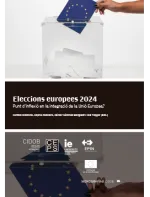Introduction. Increasingly Europeanised elections

CIDOB Monographs -88- 2024
P. 5-7. ISBN:978-84-18977-22-0
The elections to the European Parliament have commonly been considered “second-order” elections. This is not only because European citizens might view them as less important, or because of lower than normal turnouts. It is also because European elections have often been fought on national issues, with domestic debates dominating the campaigns and voters inclined to use them to punish the governing party and its action in the various member states.
We can expect to a see a repeat of some of these dynamics in the elections of June 6th-9th, 2024, when over 370 million citizens from the 27 member states are eligible to vote to elect 720 MEPs, who together will represent 450 million citizens. Since 1979, the year of the first elections to the European Parliament by universal suffrage (and the world’s first multinational elections), the chamber has grown in importance in the institutional framework of the European Union (EU).
Since the Lisbon Treaty came into force, the parliament has formed an intrinsic part of the EU’s ordinary legislative procedure (codecision). Along with the Council of the European Union, it is responsible for amending and adopting most European legislation. The figure is variable and debatable, but it is estimated that 70% of national legislation originates from EU decisions.
There are obvious reasons not to consider the European elections a second-order contest. Still, Brussels and Strasbourg remain distant cities for a good part of the people, even if the issues on the European political agenda are becoming increasingly less so. The politicisation of European affairs, and the steady rise of clashing views on them, is a growing and irrepressible phenomenon. No longer are the policies that emerge from Brussels deemed good by nature. Instead, they are a target of protest, as any local, regional or national public policy might be. This shows a level of maturity that every democratic system must reach and, therefore, it helps to build a much-desired demos and European political arena.
Examples abound. The recent protests against the European Commission’s green agenda put a halt to legislative initiatives like reducing the use of pesticides in the EU. A brake has also been placed on opening up to agricultural imports from Ukraine in the wake of demonstrations by the farming sector in multiple European capitals, including Brussels itself. A confrontation is beginning to emerge, then, between the green agenda, fighting climate change and biodiversity protection as promoted by the EU and the price to pay by the sectors most vulnerable to the green transition, in this case the agricultural sector.
Protest over initiatives and the politicisation of matters that form the European political agenda cover other areas, too. The defence of Ukraine requires a greater joint spending effort, which causes misgivings among those who balk at common fiscal endeavours, but which is welcomed by those who would like to move forward with a defence industry capable of rising to the geopolitical challenges that beset the EU. Migration issues continue to spark intense political and social debate in a good many member states. And the approval of a new pact on migration and asylum has failed to translate into greater solidarity among EU partners. The debate over the EU’s own resources, and the fiscal effort it entails, continues to set the “frugal” states against the proponents of greater fiscal integration. No key concern on the European agenda today escapes the dynamics of politicisation and Europeanisation of the political debate.
The outcome of the elections to the European Parliament will determine the future of the legislative process on many of these issues. Pro-European forces will argue that the successful management of recent crises needs a structural push to further European integration. Nationalist and Eurosceptic forces, meanwhile, will milk disgruntlement like that of the European farming sector to call for the transfer of powers back to the member states in the face of the “Brussels monster”, as Hans Magnus Enzensberger dubbed it. Legislative progress will depend on the majorities that form in the new parliament, and on the nature and composition of the new European Commission.
This monograph, the result of joint reflection led by CIDOB, CEPS and IE, and in the framework of the DigiDem-EU project funded by the European Commission’s Citizens, Equality, Rights and Values programme, sets out some of the most salient thematic areas ahead of the elections in June and, in the second part, describes the electoral outlook in various member states.
The first part, edited by Héctor Sánchez Margalef and Carme Colomina, researchers at CIDOB, tackles issues such as the future of the European green agenda (Ana García Juanatey and Andrea Noferini), the economic debates in the EU (Víctor Burguete), the geography of anti-Europeanism and the urban-rural divide (Agustí Fernández de Losada and Marta Galceran), the role of young people in the EU (Javier Carbonell), the migration phenomenon (Francesco Pasetti), defence (Daniel Fiott), foreign policy and enlargement (Ilke Toygür and Luis de Lossada i Gallart), disinformation (Carme Colomina) and the future of European integration after the elections in June (Héctor Sánchez Margalef).
The second part, edited by Sophia Russack, a researcher at CEPS, and Ilke Toygür, director of the IE Global Policy Center, brings together leading representatives of European think tanks to provide insights from Germany, France, Italy, Spain, Poland, Belgium, the Czech Republic, Hungary, Austria, Finland, Ireland and Estonia.